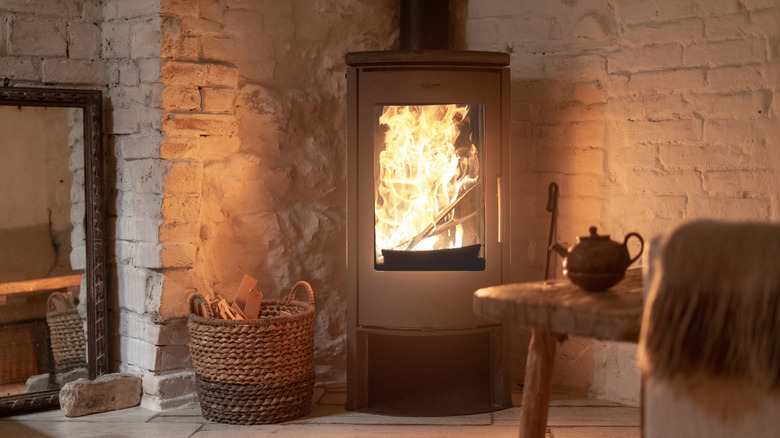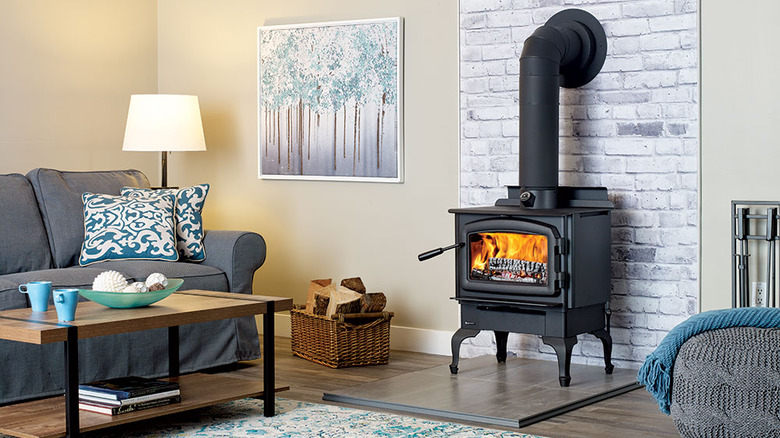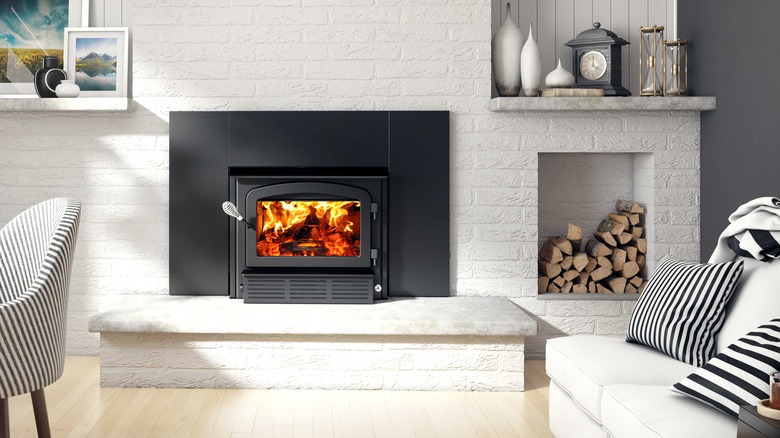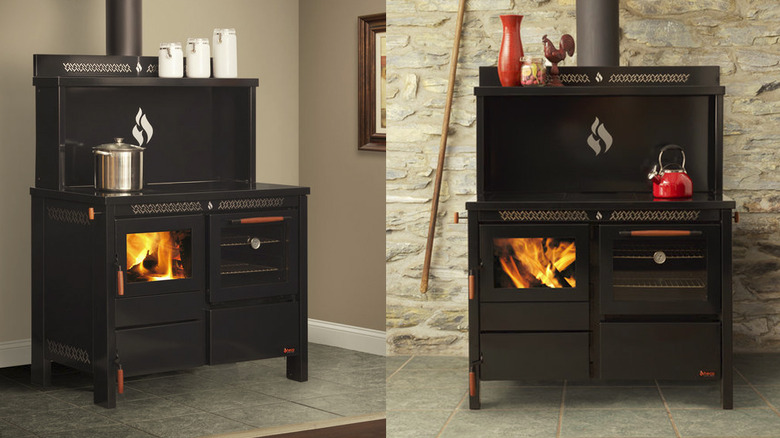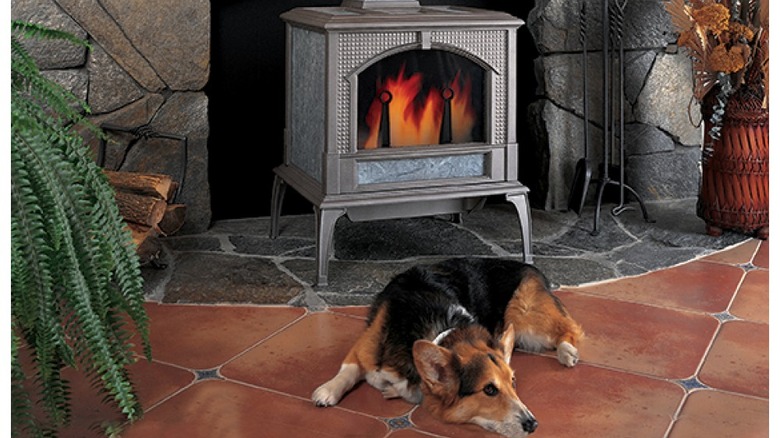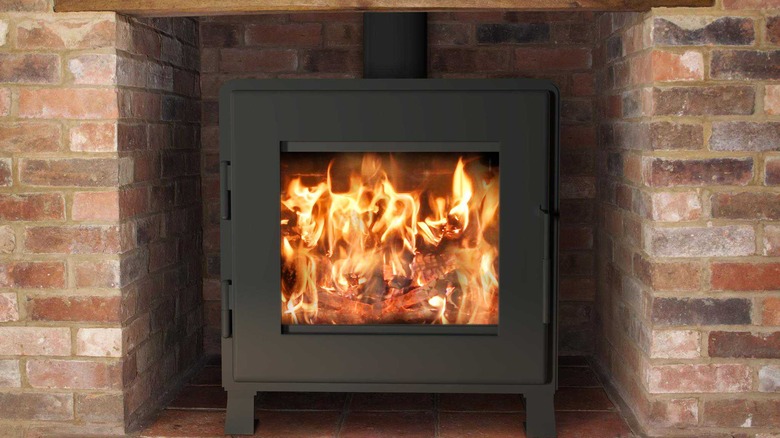5 Best Wood Burning Stoves To Keep Your Home Warm And Cozy This Winter
We may receive a commission on purchases made from links.
Wood-burning stoves have become a cozy staple in recent times. In an interview with Architectural Digest, New York-based architect Drew Lang said "Fireplaces can overwhelm some spaces, and the wood-burning stove presents a great alternative." The compact design, along with great leaps forward in emissions and efficiency have all turned an appliance from a bygone era into a modern must-have.
It isn't surprising that wood-burning stoves are surging in popularity now, as fuel prices rise and times feel uncertain. Families with access to timber know they can heat their home for free with a wood-burning stove — but there are more free resources available to those who are prepared to look. According to the Alliance for Green Heat, as well as obvious places to look such as Craigslist or Facebook, there are local, state, and federal programs that can provide you with free or discounted firewood. These stoves are much more than fireboxes though. Here are the best wood-burning stoves for your home this winter.
The best catalytic wood-burning stove
According to Forbes, the average wood-burning stove costs between $3,000 and $3,500 to buy and install. The total range can vary from $1,500 to over $5,000 as both the cost of the stove and the installation costs depend on many factors. The most important stove feature for your budget is its efficiency. Catalytic stoves recycle almost all of the gases released from wood as it burns to create more heat for a longer time, using less wood and generating fewer emissions than a stove without one, explains Alsip's.
While a catalytic stove will initially cost more than a non-catalytic model (and the catalyst will require replacement approximately every 5 years,) the savings on fuel can more than offset these costs. Regency Fireplace Products estimate that even with minimal use and a cheap (not free) wood supply, an EPA-certified stove would use $455 less wood in one season than a stove that wasn't designed to those specifications.
The Regency F1500 Cascade is a compact catalytic wood-burning stove that comes with all of the high-performance features of a cutting-edge stove, at a price that will pay for itself in lower fuel costs. In addition, it's backed by Regency's industry-leading warranty on both the stove and the catalytic converter.
Best Inset Stove
If you already have a fireplace or prefer the fireplace aesthetic to having a free-standing stove, then an inset stove could be your best choice. Per Creative Energy, these stoves are glass-fronted boxes made from fireproof material — usually steel or cast iron. They are much more efficient than a traditional open fireplace, as their self-contained design creates a closed combustion system that is able to convert 60% to 80% of its fuel into usable heat. By comparison, a traditional open fireplace has efficiency levels of only about 20%.
Inset stoves don't just reduce how much fuel you need to buy per season. According to Arada Stoves, they also save space and reduce clean-up by containing ash and debris in easy-to-empty drawers, while their typically large viewing windows give the room all of the charm and character of an open fireplace.
The Drolet Escape 1500-I is a highly recommended, Canadian-built insert wood-burning stove that can heat up to 1,800 square feet at a 70% efficiency rate. The Drolet also boasts an impressively low particulate emissions rate — 1.26g/hr. For context, that is 50% under the new, more stringent 2020 EPA requirements, which stipulate a maximum of 2.5g/hr for cord wood-burning stoves (via EPA).
The best stove for cooking
For those who dream of simultaneously heating their whole home and cooking using that same heat, there are some wood-burning stove options with a lot of extra features. While it's often possible to put a cast-iron skillet or a kettle on top of a regular wood-burning stove, for more regular use, you may want to consider a wood cookstove.
The Heco brand of wood-burning cookstoves is produced by members of the Amish community of Lancaster County, Pennsylvania — a group that understands self-sufficiency and has little time for short-sighted shortcuts. Per Cookstove Community, they produce cookstoves with the same mentality that has kept their community strong over the years, creating stoves with superior materials that conform to modern emissions standards.
Their largest cookstove, the Heco 520, burns either wood or coal and is capable of heating up to 2,500 square feet with burn times of 13 hours or more. Moreover, it has a stovetop, an oven, thermostats, and an optional stainless steel water coil for domestic water heating. If you want to consolidate all of your home's wood-burning and heating needs into one unit, this stove is for you.
The best soapstone wood-burning stoves
The typical material we associate with wood-burning stoves is cast-iron. Some parts might be made of toughened steel, but for the heft, thermal mass, and durability, cast iron is an excellent choice. However, it might surprise you to learn that it isn't actually the best material to make a wood-burning stove from. As Woodstove Wizard explains, soapstone stores more energy for its mass than any other naturally-occurring material — almost twice the level of iron. Unlike other rocks that can store and release heat (such as marble or granite,) soapstone won't crack under the high intensity of direct heat.
According to the EPA, the highest overall efficiency rating ever awarded for a cordwood (i.e. logs not pellets) stove is 81%. Right behind that, with a score of 80% (which is four times more efficient than an open fireplace,) are two flagship stoves from the Woodstock Soapstone Company — The Palladian and The Keystone. Per Firewood for Life, Woodstock Soapstone has a reputation for going above and beyond in terms of craftsmanship and materials.
These hyper-efficient stoves will comfortably heat 1,300 square feet, burning for 8 to 10 hours at a time, while generating tiny emissions of 0.84g/hr. Moreover, because they are built using soapstone, they will gently and evenly radiate the heat well after the fire itself has gone out.
The best 21st-century wood-burning stoves
Part of the charm of a wood-burning stove is nostalgia for the past, the directness of using natural fuel to stave off winter's chill, and the hypnotic effect of the glowing tongues of fire. But progress waits for no one, and modern forces are disrupting the stove industry.
MF Fire was formed when a team from the University of Maryland entered a competition to design innovative, low-emissions stoves in 2013. They were the only university team to enter, beating industry veterans to place first in emissions and coming fourth in efficiency, notes Popular Mechanics. This was followed a year later by picking up multiple awards at both the RECESS Pitch contest and the MIT Clean Energy Prize (via University of Maryland). More recently, the team won two million dollars worth of grants offered by the Department of Energy to improve efficiency, safety, and emissions even further, according to Technical.ly.
The MF Fire Nova 2 is the new flagship model. It heats homes of up to 2,500 square feet, with a maximum efficiency of 81%, and has a maximum heat output that is impressive for a stove of its size. While the Regency F1500 (featured above) is an industry-leading unit that can produce 55,000 BTU/hr, the Nova 2, which is actually smaller, produces up to 75,000 BTU/hr. Instead of paying extra for gimmicky features, investing in true technical innovation like this will keep your home cozier and your wallet heavier.
